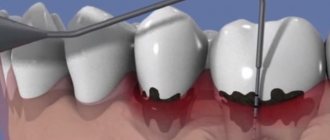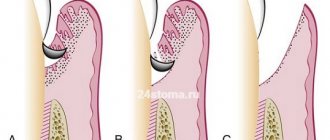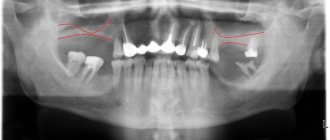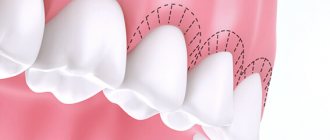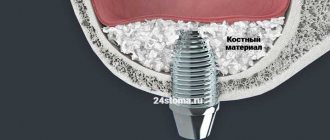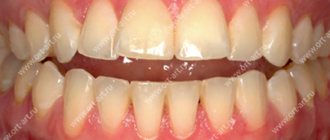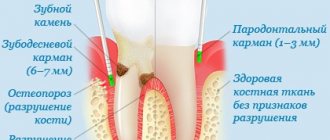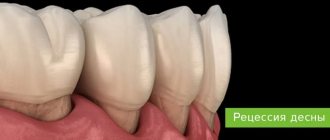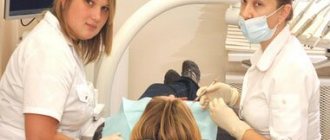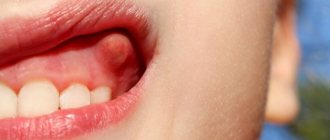In order for the treatment of periodontitis to end successfully and be effective, it is necessary to free the teeth from deposits. It is in them that microbes and decay products of various life processes can accumulate. This irritates the gums and causes them to become inflamed.
The most effective in this case is curettage. This is the treatment of periodontitis by scraping periodontal pockets. During this event, not only dental plaque is eliminated, but also pathologically altered tissues, all microflora and their metabolic products, and the results of tissue decay.
A periodontal pocket is an area formed due to the destruction of bone tissue. In this case, there is no attachment of the gum to the surface of the tooth in the area. Typically, over time, it fills with deposits, pus, and granulation tissue.
There are several surgical techniques for diagnosing periodontitis:
- curettage of periodontal pockets;
- patchwork operations.
The cause of inflammatory diseases of the tissues that surround the teeth is often the accumulation of soft plaque. If hygiene is not observed and care is insufficient, tartar forms. The consequences of diseases such as periodontitis or gingivitis include loosening and loss of teeth. It also promotes the development of pathogenic bacteria, which cause inflammatory diseases.
How to do curettage
Curettage is a surgical operation. Plaque, stone, and pathological tissue are removed from the periodontal pocket. If necessary, osteoplastic surgery is performed. This is necessary if bone resorption has already begun.
Curettage must be carried out in the treatment of periodontitis and periodontal disease, as this is one of the most effective methods for eliminating inflammation in the gums. According to the technology of the procedure, there are two types of it:
- Open;
- Closed.
Closed curettage
Can be used if the depth of the periodontal pocket does not exceed 5 mm, and pathological changes in the bones have not yet begun. When performing closed curettage, pathological tissues are exposed to ultrasound and hand instruments in the form of hooks, with the help of which granules are removed from under the gums. There is no cutting of the gums, so the procedure can be considered more gentle.
Flaws:
- The doctor performs the operation almost blindly; he does not see the subgingival space. Therefore, it is not possible to thoroughly clean the periodontal pocket in all cases.
- There is a risk of incomplete cleaning. Success largely depends on the experience of the dentist performing the procedure.
Due to its characteristics, closed curettage is suitable for mild to moderate periodontitis and periodontal disease. Sometimes it becomes the only possible method, since others cannot be used for some reason.
Causes of periodontitis
In most cases, the onset of the disease is preceded by mechanical damage. It can be one-time (injury) or permanent (rubbing against an incorrectly installed prosthesis). As a result, pathogenic microorganisms penetrate into and under the gums.
Inflammation also provokes:
- plaque;
- tartar;
- low quality prosthetics;
- insufficient oral hygiene;
- increased load on the teeth as a result of the loss of some of them;
- malocclusion;
- smoking;
- age.
First, the upper layers of tissue become inflamed, and gingivitis begins. It does not always lead to periodontitis, but it always precedes it. Bleeding gums and bad breath are reasons to consult a doctor.
If gingivitis is not treated, it becomes chronic. The inflamed tissue becomes loose, and more and more bacteria penetrate into it. They get lodged under the gum, destroying the ligament around the tooth root. A space appears between the tooth and gum - a periodontal pocket. It accumulates minerals, waste products of bacteria, and the remains of dead tissue. Tartar forms. To get rid of it, dental curettage is performed as part of a comprehensive treatment of periodontal inflammation.
Open curettage
Used if the depth of periodontal pockets is more than 5 mm. This is a surgical intervention, but compared to a closed one, the effectiveness is much higher. Since open curettage requires cutting into the gums, the operation is performed under anesthesia.
Stages:
- The doctor cuts the gum and peels it away from the tooth. After exfoliation, the tooth root is completely exposed. The dentist gets full access to the bone tissue.
- Cleaning and antiseptic treatment. The roots are cleaned of accumulated plaque and stone and polished using a burr and special pastes. After this, the tissues are treated with an antiseptic.
- Osteoplasty. This stage is not always necessary. With advanced periodontal disease, bone resorption gradually begins around the teeth, which will lead to loosening and tooth loss. In order to restore the bone, osteoplastic material is implanted.
- Suturing. After plaque removal, the gingival flap is returned to its place and sutured. A bandage with an antiseptic solution is applied on top.
Open curettage is a more complex procedure, but more effective than closed curettage. The surgeon sees the entire subgingival space and has access to bone tissue. Therefore, the quality is very high; both plaque and granulation tissue are completely removed from under the gums.
If necessary, open curettage can be performed simultaneously with flap surgery. It is indicated if the gum tissue is loose and the gum contour is disturbed. Very often, with periodontal disease, the gums begin to overhang the teeth. This violates the aesthetics of a smile. During flap surgery, the dentist removes excess mucous membrane and then sutures the gum.
Closing gum recessions
Closing gum recessions is carried out only by surgical methods, which involve moving donor flaps to the recession zone and plastic surgery of the existing defect. You can receive a transplant in several ways:
- Pedicled flap. In this case, the donor tissue is a nearby area of the mucous membrane. The technique is used in the presence of localized defects.
- Gingival flap. It is taken from the gum area, provided that the volume of tissue in the selected area is sufficient.
- A scrap from the sky. In this case, the donor fragment is taken from a specific area of the hard palate
To close recession zones, the method of directed tissue regeneration can be used. In this case, special membranes are used as donor tissue, which can be absorbable or non-absorbable. These membranes promote the migration of cells from natural tissues and subsequent regeneration of the damaged area.
This method does not require the formation of a donor wound, but is not suitable for all patients. To obtain a successful result, the membrane must be covered with a layer of mucous membrane, which will provide the necessary nutrition, which is not always possible. In addition, due to the long process of formation of new tissue, it is necessary to observe certain rules of oral hygiene, therefore this method requires the active and conscientious participation of the patient in the treatment process.
Rehabilitation
Curettage of periodontal pockets is a surgical operation, after which there will be a period of rehabilitation. Following the recommendations will speed up gum healing, make it less uncomfortable, and avoid complications.
Oral care rules depend on the method:
- Closed curettage. Immediately after surgery, you should not eat for several hours. On the first day, it is better to refrain from brushing your teeth with a brush and toothpaste, replacing it with rinsing. During the entire rehabilitation period, you need to monitor your diet - exclude solid foods and foods containing dyes. After curettage, there may be increased sensitivity of the teeth and gums. A special paste that your doctor will recommend will help you remove it. It is imperative to rinse your mouth with solutions of strengthening and anti-inflammatory medications.
- Open curettage. Since this surgery requires cutting into the gum, recovery takes longer. Recommendations for the first 1-2 days after surgery are the same as for closed curettage. It is very important to minimize the possible stress on the gums and teeth. It is advisable to reduce physical activity at first. Until the stitches heal, your mouth should be rinsed with solutions of antibacterial and anti-inflammatory agents. This will help speed up healing and tissue regeneration.
Plastic surgery of lip cords and frenulums
In the presence of pronounced strands of the mucous membrane, the risk of periodontal disease increases significantly. Massive folds that are fixed to the gingival papillae, when stretched, can displace them and lead to various problems. In order to prevent such conditions, band plasty is performed. Typically, the technique consists of excision of these folds and subsequent suturing of the resulting defect.
Lip frenuloplasty can be performed in the following cases:
- Pronounced tooth gap between the front incisors.
- Preparation for orthodontic treatment.
- Presence of gum recession.
- Before installing removable dentures.
- Incorrect sound pronunciation.
Surgical treatment can be performed in various ways. If the frenulum is very narrow, then it is cut transversely. If there is a wide frenulum, its excision is performed. In addition, individual sections can be moved to the desired position.
Among modern techniques, laser frenuloplasty is noted. The procedure is very quick, does not require stitches, has a short recovery period and rarely leads to complications.
After plastic surgery of the cords and labial frenulum, a period of rehabilitation begins. Typically, the patient is required to follow simple rules, which include careful oral hygiene and a certain diet. Typically, recovery takes about a week.
Flaws
Gum curettage is a simple dental operation with good results. However, it is not without its drawbacks:
- Traumaticity. Like any surgical intervention, curettage injures soft tissue.
- The need for anesthesia. Normally, the operation is performed under local anesthesia. Sedation or general anesthesia is used in extreme cases or when the patient is in panic.
- Rehabilitation. The gums heal quickly, but at this time it is necessary to follow the recommendations and take care of the oral cavity. Infection of the wound can lead to complications.
Are there complications?
The procedure is safe and is carried out in strict compliance with all technology requirements.
But there are several potential problems that may arise as a result of personal characteristics of the body or non-compliance with requirements during the rehabilitation period.
These include the following:
- Sensitivity to food temperature . It occurs in almost everyone, but goes away over time. The maximum duration of hyperesthesia is up to two months. To cope with the problem, you can use special gels, ointments, toothpastes and rinses - the dentist will advise which ones.
- Swelling and hematoma . They may not go away for up to two weeks, but do not pose a serious danger.
- Problems in the functioning of the facial muscles . You should not be afraid of such a manifestation, because it will pass in about 10 days. Some patients complain of difficulty opening the mouth, but this also resolves in no more than 12 days, more often earlier.
- Increased tooth mobility . Observed for up to three weeks. For this reason, you need to pay attention again to your diet and remove foods that are too hard.
The patient's condition is constantly monitored by an experienced dentist, so that any serious complications can be avoided.
Alternatives to curettage
Alternative technologies are suitable as prevention or in the early stages of pathology development. At the Zuub clinic they use:
- Comprehensive teeth cleaning. This is good prevention. It can be used as one of the stages of complex therapy, but not as an independent treatment. During cleaning, using ultrasound and a mixture of water, air and soda, tartar and plaque are removed from the surface of the teeth. You won't be able to empty your pockets this way.
- Treatment with the “Vector” device. A method for cleaning and disinfecting shallow periodontal pockets. In mild stages of periodontal disease, it can be used as an alternative to closed gum curettage, but it cannot replace open vector therapy. "Vector" is more effective than classic complex cleaning. It is based on a combination of exposure to an ultrasonic wave and a special suspension with abrasive particles. Since the ultrasonic wave is applied vertically, it penetrates deeply under the gum. In addition, ultrasound has a good disinfecting effect. Thanks to this, with a small depth of periodontal pockets and an undeveloped pathological process, it can give a good result.
The periodontist selects the gum treatment technology based on the clinical picture.
Come for a consultation with a dentist at the Zuub clinic.
Indications for surgery
The physiological depth of the periodontal pocket is 1.5-2.5 mm. With a depth of more than 3 mm, the pocket is considered pathological and requires intervention.
Other indications are:
- intensive deposition of tartar;
- plaque;
- inflammatory processes in the periodontium.
Tartar removal is an important, but not the only component of treatment. It includes:
- Anti-inflammatory therapy.
Its goal is to reduce swelling, pain, and bleeding of the gums. Periodontal pockets are washed with antiseptic solutions, and antimicrobial and anti-inflammatory drugs are prescribed. - Physiotherapy.
Light therapy, darsonval, electrophoresis, laser, gum massage are designed to activate blood circulation, tissue regeneration, and relieve pain. - Surgery.
Treating a gum pocket is just one of the surgical procedures. Infected tissue and abscesses are surgically removed. They replant tissues and cover exposed roots. - Orthopedic treatment.
Teeth are given stability by splinting, using dentures or light-curing sutures. For prosthetics, removable and fixed dentures are used, depending on the number and condition of the teeth.
